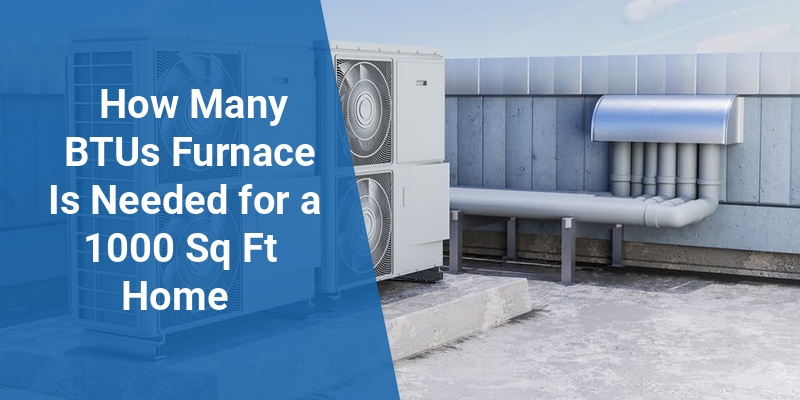Choosing the right furnace size is critical for efficient heating and comfort in a home. Homeowners often ask, how many BTUs of furnace capacity are required for 1000 sq ft of living space? This article explains the factors influencing furnace sizing, provides a general heating capacity guideline, and highlights important considerations to ensure optimal furnace performance.
| Home Size (Sq Ft) | Estimated BTU Requirement | Key Influencing Factors |
|---|---|---|
| 1000 | 30,000 to 40,000 BTUs | Climate, insulation, ceiling height, windows, air leakage |
Understanding BTU and Furnace Capacity
BTU stands for British Thermal Unit, which measures the amount of heat needed to raise the temperature of one pound of water by one degree Fahrenheit. In heating systems, BTU ratings indicate furnace capacity. A furnace with a higher BTU rating can produce more heat, suitable for larger or less insulated spaces.
Accurate BTU sizing prevents overheating, energy waste, and premature equipment wear. Oversized furnaces cycle on and off frequently, while undersized units may struggle to maintain comfort during cold spells.
General BTU Guidelines for a 1000 Sq Ft Home
The general rule of thumb for a moderately insulated home in a temperate climate is between 30 to 40 BTUs per square foot. This means a 1000 sq ft house would require approximately:
- 30,000 to 40,000 BTUs for heating capacity
This range covers most average homes but varies depending on specific factors discussed below.
Key Factors Affecting Furnace BTU Requirements
Climate Zone
Homes in colder climates need furnaces with higher BTUs. For example, northern states may require a furnace that outputs above 40 BTUs per sq ft, while southern states may need less than 30 BTUs per sq ft.
Insulation Quality
Well-insulated homes retain warmth better, reducing BTU needs. Older homes with poor insulation require more heating power. Adding insulation or sealing leaks can reduce furnace size requirements.
Call 888-906-9139 for Free Local HVAC Quotes – No Obligation, Just Savings!
Ceiling Height and Home Layout
Higher ceilings and open floor plans increase the volume of air to heat, possibly increasing BTU requirements beyond simple square footage estimates.
Windows and Doors
Homes with many windows or single-pane glazing lose more heat, demanding a furnace with more heating capacity.
Calculating BTU Requirements More Precisely
For precise sizing, heating professionals perform Manual J heat load calculations that consider:
- House square footage and ceiling height
- Insulation levels in walls, floors, and attic
- Number and type of windows and doors
- Local climate data and outdoor design temperature
- Desired indoor temperature settings
This method ensures the furnace perfectly matches the home’s heating needs.
Potential Issues with Incorrect Furnace Sizing
- Oversized Furnaces: Short cycling leading to inefficient operation, excessive wear, and uncomfortable temperature swings.
- Undersized Furnaces: Insufficient heating, longer runtimes increasing energy bills, and increased wear risk due to overuse.
Energy Efficiency Considerations
Selecting a furnace with the right BTU rating is vital, but the system’s efficiency rating (AFUE – Annual Fuel Utilization Efficiency) also impacts operating costs. A high AFUE furnace uses fuel more effectively, reducing energy bills regardless of size.
Pairing proper sizing with efficient equipment yields the best long-term comfort and savings.
Summary of Furnace BTU Estimates for a 1000 Sq Ft House
| Climate Zone | Estimated BTU Range | Notes |
|---|---|---|
| Cold (Northern US) | 35,000 – 45,000 BTUs | Higher BTU due to heat loss demands |
| Moderate (Mid US) | 30,000 – 40,000 BTUs | Typical insulation and moderate climate |
| Warm (Southern US) | 25,000 – 35,000 BTUs | Lower BTU demand due to mild winters |
Choosing the Right Furnace Type for 1000 Sq Ft Homes
Several furnace fuel types are available, affecting installation cost and efficiency:
Call 888-906-9139 for Free Local HVAC Quotes – No Obligation, Just Savings!
- Natural Gas Furnaces: Most common in many regions, efficient and cost-effective.
- Electric Furnaces: Easier to install but often more costly to operate.
- Oil Furnaces: Used in areas without natural gas access, require more maintenance.
- Propane Furnaces: Alternative where natural gas pipelines are unavailable.
Choosing a fuel type depends on availability, cost, and personal preference.
Professional Consultation and Installation
For best results when selecting furnace size, consult a licensed HVAC professional. They can conduct detailed heat load calculations, recommend appropriate furnace units, and ensure proper installation for optimal performance and safety.
Incorrect sizing or DIY installation risks reduced comfort and increased utility costs.
